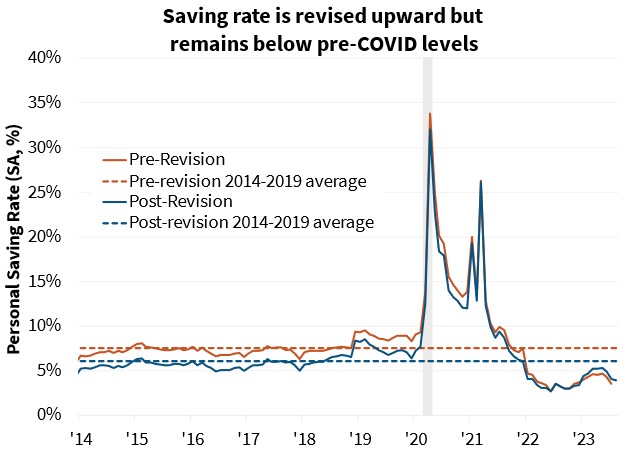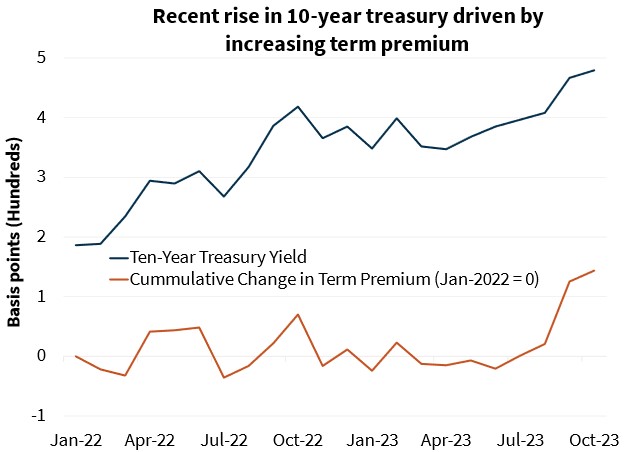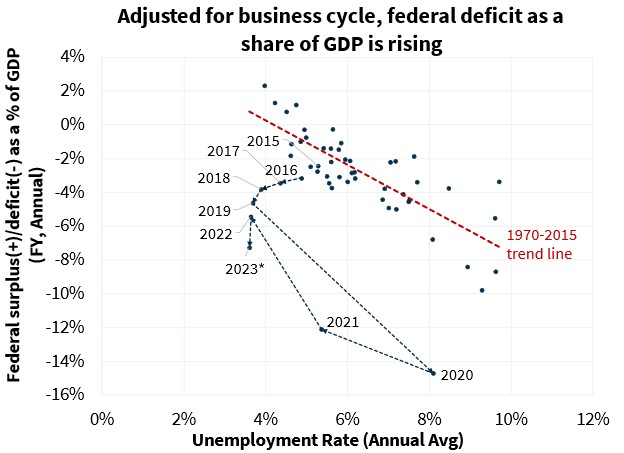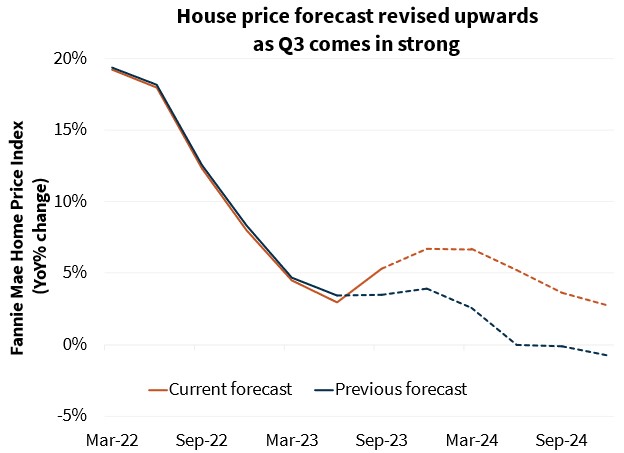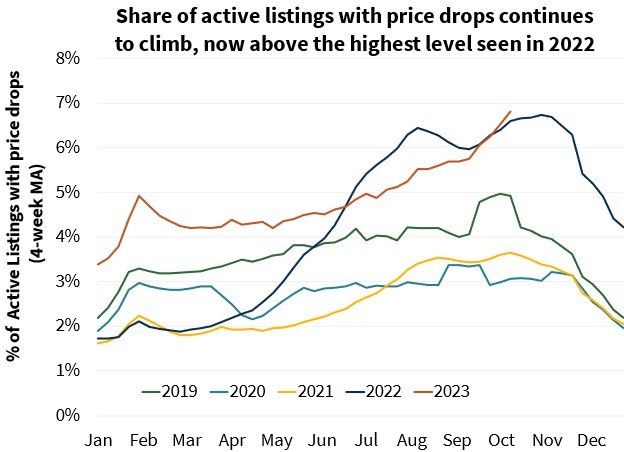Data Revisions Paint More Optimistic Economic Picture, While Long-Term Interest Rates Rise
Our baseline economic outlook was revised upward largely on the strength of incoming third quarter indicators and significant data revisions to historical series. We now expect 2023 real gross domestic product (GDP) to grow 2.5 percent on a Q4/Q4 basis, up from 2.2 percent, and 2024 growth to be negative 0.1 percent, up from negative 0.2 percent. Conceptually, our view of a decelerating future growth path remains intact; however, the combination of revisions to historical GDP and other national income accounts data, and the recent brisk rise in longer-term interest rates has changed our view of the risk dynamics around the forecast. Data revisions now show that consumer incomes are less out of line with the historical relationship to spending trends than previously reported, suggesting a higher chance of a “soft landing” being achieved than we had previously expected. However, conversely, the rapid rise in longer-term interest rates over the past few months will put more downward pressure on economic activity going forward and increases the risk of financial market turbulence, asset repricing, and other acute events, such as what occurred during the spring bank failures. It should be noted that there is also heightened uncertainty over the outlook stemming from a combination of ongoing major labor strikes, a potential Federal government shutdown, and geopolitical developments in the Middle East and elsewhere.
We have updated our quarterly house price forecast, revising upward our growth projection for 2023. As measured by the Fannie Mae Home Price Index (FNM-HPI), we expect prices to have grown by 6.7 percent on a Q4/Q4 basis, up from our previous forecast of 3.9 percent. The upgrade is largely due to higher-than-expected incoming transaction data over the third quarter. House prices have proven to be more resilient than expected in light of higher mortgage rates and affordability challenges. Going forward, we still anticipate house price deceleration and predict 2024 house price growth will slow to 2.8 percent on a Q4/Q4 basis.
Our total home sales forecast was revised downward slightly, driven by a higher mortgage rate outlook. We forecast sales to be 4.81 million and 4.80 million in 2023 and 2024, respectively, down from our prior forecast of 4.84 million and 4.88 million, respectively. Despite the lower sales forecast, due to the higher house price outlook, our forecast for mortgage origination volumes was unchanged for 2023 at $1.56 trillion and revised slightly upward for 2024 to $1.90 trillion (previously $1.88 trillion).
Data Revisions Point to A Stronger Economy
The Bureau of Economic Analysis’s 10-year comprehensive update of the National Income and Product Accounts (which includes GDP measures) showed that the overall size of the economy was larger than previously reported, though the recent GDP growth trend was only modestly changed. Some of the underlying details, however, paint a different picture of the current state of the economy. We have previously discussed that real personal consumption expenditures had outpaced real income gains since roughly the beginning of 2022, as consumers spent down accumulated pandemic-era savings and took on more debt. This trend is unsustainable in the long run, and we have argued previously that this would lead to downward pressure on consumer spending while increasing the likelihood of a recession. However, the gap between these two series relative to pre-pandemic has been revised to be significantly smaller, as reflected in the savings rate data. This suggests that consumption does not in fact need to pull back as significantly in order to come into better balance with incomes. The current personal saving rate, which declined to 3.9 percent in August, is still below what we expect to be sustainable, reflecting consumer spending growth over the past two months outpacing income growth. However, the eventual correction is now likely to be smaller than previously anticipated.
In the near term, we expect that downward revisions to Q2 2023 net exports, combined with a stronger-than-expected gain in exports for August, will translate into a stronger-than-previously-expected Q3 2023 GDP growth number. The Q3 number was already poised to be strong primarily due to a surge in consumer spending in July, but with the net export data, we have revised upward our Q3 2023 GDP growth forecast from 3.5 to 4.9 percent annualized. Also contributing to the stronger third quarter assessment was a higher-than-expected employment report in September, in which payrolls rose by 336,000 and the prior two months were revised upward by a cumulative 119,000 jobs.
Despite this robust Q3 2023 GDP estimate, we believe growth is still likely to decelerate sharply in the fourth quarter. While real consumer spending was strong in June and jumped 0.6 percent in July, real disposable income growth has been negative in each month from June through August. Spending was softer in August, growing just 0.1 percent, and, while the data is noisy, high frequency credit and debit card data suggest some consumer spending retrenchment in September. Additionally, higher interest rates and declining bank lending for auto loans suggest weaker auto sales going forward. The boost to growth from net exports in Q3 is also likely to be short lived. Part of the upward revision to net exports was due to a sharp 1.9 percent drop in real imports in August, implying both weaker anticipated consumer and business demand on the part of firms. Additionally, while real exports have been on the rise since April, the recent surge in interest rates has increased the strength of the dollar, making U.S. exports less attractive. Combined with weak global economic growth, we expect net exports will subtract from GDP in the fourth quarter.
The Recent Rapid Rise in Long-Term Interest Rates is Different Than Last Year
The 10-year treasury yield began July at around 3.8 percent. Just three months later, rates were about one full percentage point higher, with the 10-year closing as high as 4.81 percent on October 3. As of this writing, daily yield movements have been volatile following the conflict in Israel, but they remain near the highest levels since 2007. The cause of the recent run-up in long-term rates is multifactorial and likely includes some expectation of more resilient economic growth coupled with a higher-for-longer monetary policy stance from the Federal Reserve. However, unlike rate increases in the fall of 2022, the recent increase in longer-term yields is principally due to a rising “term premium,” up about 100 basis points since June, according to New York Federal Reserve estimates. This is the added yield that cannot be accounted for by the average of market pricing of future expected short-term rates, possibly reflecting rising risk around future interest rates. This distinction is important for economic growth prospects, as rising long rates due to stronger economic growth expectations (and therefore higher-for-longer Fed policy rates) is a bullish indicator. However, if the drive upward is due to rising term premium, the rise has a contractionary effect and increases downside risks to growth.
We believe the primary driver of the rising term premium is from financial markets reacting to a surge in Treasury debt issuance following the debt ceiling standoff this past June, and possibly adjusting expectations of future issuance. Combined with the Federal Reserve running off its Treasury portfolios and commercial banks holding cash in part to cover losses on long duration bonds, the marginal Treasury investor is demanding additional yield while supply is increasingly high. Based on our estimate for September, we expect the fiscal year 2023 federal deficit to have been around 7 percent of GDP, a level only historically experienced during deep recessions or war time. With aging demographics causing growing retirement and healthcare benefit expenditures, and the prospect of higher long-term interest rates, deficit pressures are only growing.
Aside from the effects of rising rates on housing activity, rapidly increasing interest rates increase the likelihood of a weak point somewhere in the financial system “breaking.” But even aside from an acute event, the rising longer-term yields are leading to further tightening of credit conditions and effectively doing the job of further short-term rate hikes. Multiple Fed officials have made comments to this effect in recent weeks, and we suspect that this line of thinking will lead to the Fed being done with additional rate hikes. The turning of the credit cycle is ongoing, and over time both consumers and businesses will need to roll their current low interest debt into higher rates, which will weigh on consumption, business investment, and hiring. Financial conditions are broadly tightening, and bank lending, especially in areas such as commercial real estate, is contracting. Combined, we continue to believe these forces will eventually act to push the economy into a modest recession, with our baseline still being in the first half of 2024.
Home Prices Remain Resilient, Though Deceleration Likely Ahead
Our upward revision to our 2023 house price expectation was largely driven by stronger-than-expected price gains over the third quarter. According to the FNM-HPI, house prices rose by 2.0 percent over the quarter on a seasonally adjusted basis and were up 5.2 percent from a year prior (compared to our prior forecast of a 3.5 percent annual increase ). Despite higher mortgage rates and affordability pressures, the ongoing lack of listings available has continued to support house prices. However, we expect home price growth to decelerate going forward, especially in light of the recent rise in mortgage rates. Recent data from Redfin shows a moderate move upward in the share of listings in recent weeks having price cuts. The share was at 6.8 percent during the week of October 11, up from 5.8% a month earlier.
In line with our expectations, existing home sales fell by 0.7 percent in August to an annualized pace of 4.04 million units. Given that closings in the month of August represent sales contracts signed on average 30-45 days previously, August sales data does not yet reflect the recent run-up in mortgage rates from 6.71 percent at the end of June to 7.57 percent as of the time of this writing, according to the latest Freddie Mac Survey. Comparatively speaking, due to an increasing share of home sales being either cash purchases or representing life cycle-driven events that are not as interest rate sensitive, we expect that further declines in sales from the recent jump in mortgage rates will be muted relative to declines from the rate run-up in 2022. That said, we believe the sales pace is likely to slow in coming months, as illustrated by mortgage purchase applications declining in recent weeks to just above the lowest level since 1995. Looking at Fannie Mae Mortgage applications data from our proprietary Desktop Underwriter® (DU®) platform, the median debt-to-income (DTI) on approved loans in June and July was 41.7 percent. If we replaced those same applications with today’s mortgage rates, the median DTI increases to 44.0 percent, suggesting a fair number of those loans would no longer qualify under typical DTI thresholds, assuming no other changes to documented incomes occurred. In reality, incomes may not be static, and applicants may choose to instead purchase less expensive homes, but this highlights the downward pressure on sales and sale prices going forward. With purchase mortgage applications pulling back further in recent weeks, we have downwardly revised our existing home sales forecast for coming quarters and now expect the annualized sales pace to fall below 4 million units in the fourth quarter of 2023, the first time this will have occurred for a quarter since 2010 following the Great Financial Crisis and the expiration of a temporary first-time homebuyer tax credit. We forecast existing sales for both 2023 and 2024 to be 4.13 million.
New home sales continue to hold up comparatively well as the lack of existing home inventory drives many buyers toward new home construction. Homebuilders continue to buy down mortgage points to help drive sales while enjoying sizable margins, especially in light of a softening in materials input costs over the last year. Still, the National Association of Home Builders (NAHB) Housing Market Index (a measure of homebuilder confidence) fell in August and again in September, ending seven consecutive months of increases. New home sales pulled back by 8.7 percent to 675,000 in August, in line with our expectations. We forecast some modest further declines in both new single-family sales and starts in coming quarters, but they will remain comparatively strong relative to existing sales as inventories remain tight.
Multifamily construction starts fell sharply in August by 26.3 percent to an annualized pace of 342,000 units, the slowest since May 2020 following the COVID outbreak. While the series is notoriously volatile, the large drop finally brings the Census Bureau’s starts series more in line with alternative private measures that have indicated weakness in starts in recent months. With sluggish rent growth on a national level, more normalized vacancy rates, and tighter construction and development loan lending standards, we expect multifamily construction starts to remain subdued for the foreseeable future. There continues to be a large pipeline of multifamily housing coming online, which we also believe will help put downward pressure on single-family housing demand in many markets, as the rent-to-buy calculus for many prospective homebuyers is increasingly looking more favorable to renting, especially in light of the recent jump in mortgage rates.
Mortgage Originations Revised Slightly Upward and Updates to Historical Estimate
We updated our historical estimate of 2022 single-family mortgage originations as a result of our annual benchmarking to the latest Home Mortgage Disclosure Act (HMDA) data. This resulted in a minor downward revision to total 2022 origination volume, with purchase volume revised upward by $11 billion to $1.6 trillion and refinance volume revised downward by $23 billion to $730 billion.
Our forecast for 2023 mortgage originations remains roughly unchanged from last month at $1.3 trillion. In 2024, we expect purchase volumes to grow 10% to $1.4 trillion, an upgrade of $7 billion from last month’s forecast, as our stronger home price expectation outweighs minor downward revisions to the sales forecast.
For refinances, our 2023 projection is also essentially unchanged from last month. In 2024, we now expect volumes to be $456 billion, an upward revision of $14 billion from last month’s forecast, as our higher home price expectation outweighs the higher rates expectation, given the limited rate sensitivity of refinance volumes at this point.
Economic & Strategic Research (ESR) Group
October 12, 2023
For a snapshot of macroeconomic and housing data between the monthly forecasts, please read ESR’s Economic and Housing Weekly Notes.
Data sources for charts: Bureau of Economic Analysis, New York Federal Reserve, Bureau of Labor Statistics, Treasury Department, Census Bureau, Fannie Mae
Opinions, analyses, estimates, forecasts and other views of Fannie Mae's Economic & Strategic Research (ESR) Group included in these materials should not be construed as indicating Fannie Mae's business prospects or expected results, are based on a number of assumptions, and are subject to change without notice. How this information affects Fannie Mae will depend on many factors. Although the ESR group bases its opinions, analyses, estimates, forecasts and other views on information it considers reliable, it does not guarantee that the information provided in these materials is accurate, current or suitable for any particular purpose. Changes in the assumptions or the information underlying these views could produce materially different results. The analyses, opinions, estimates, forecasts and other views published by the ESR group represent the views of that group as of the date indicated and do not necessarily represent the views of Fannie Mae or its management.
ESR Macroeconomic Forecast Team
- Doug Duncan, SVP and Chief Economist
- Mark Palim, VP and Deputy Chief Economist
- Eric Brescia, Economics Manager
- Nick Embrey, Economics Manager
- Nathaniel Drake, Economic Analyst
- Richard Goyette, Economic Analyst
